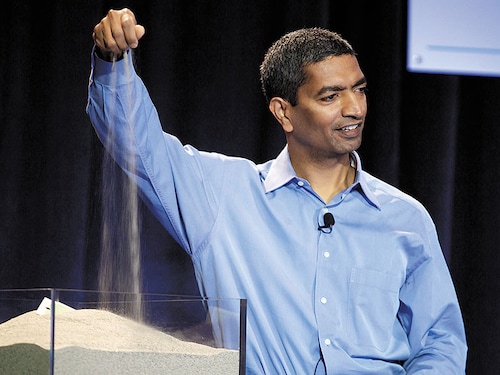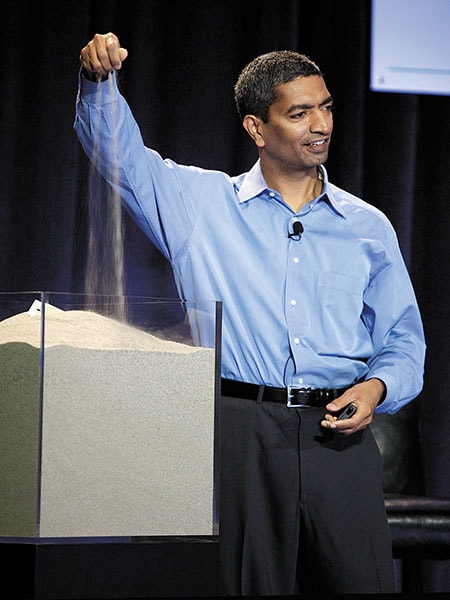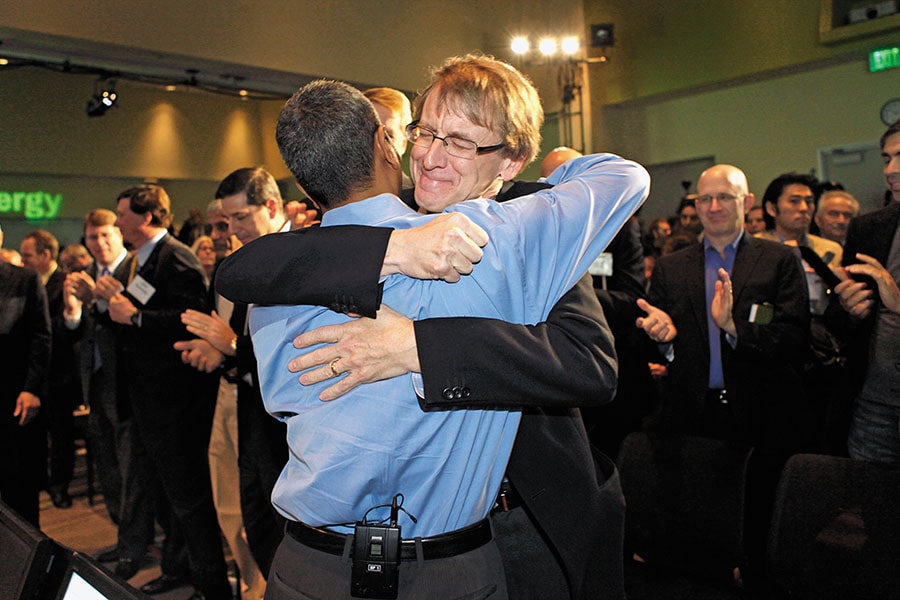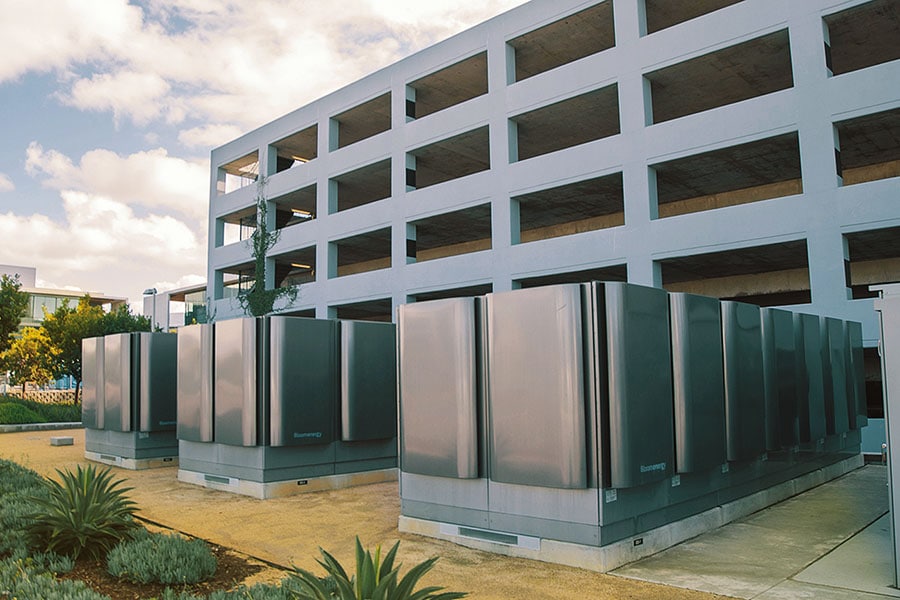KR Sridhar's bloom and bust story
The Forbes Investigation: How Bloom Energy blew through billions promising cheap, green tech that falls short


 K. R. Sridhar, Founder and CEO of Bloom Energy
K. R. Sridhar, Founder and CEO of Bloom Energy
Kim Kulish / Corbis Via Getty Images
Editor’s Note: This Forbes magazine story went to press several days before Bloom Energy’s February 12, 2020, disclosure that it would be restating its prior four years’ financial statements, lowering revenue by up to $180 million, and adding $75 million to losses. Shares traded down 10% the following day.
As wildfires raged last October, more than a million northern Californians suffered through blackouts, their electricity cut in order to reduce the likelihood of high winds sparking new conflagrations. In smoke, KR Sridhar smelt opportunity. His company, publicly traded Bloom Energy, sells fuel cells—steel boxes that generate electricity using natural gas. The boxes, which it calls energy servers, emit a nearly pure stream of carbon dioxide, a major greenhouse gas, but they are supposed to make much less of it than traditional power plants and do so without generating lots of smog ingredients like nitrogen oxide and sulfur oxides.
Even better, Bloom’s units get their fuel via underground pipelines unaffected by the Diablo winds that threatened California’s high-voltage wires and led to the power outages that Sridhar considers intolerable in any modern society, let alone in Silicon Valley.
“Every time there is a disaster, your power price is going to go up, because somebody has to pay for the damage,” Sridhar says. “That is the catalyst for change.” Bloom is capitalising on the outages by wooing potential customers in fire-risk zones to protect against grid failure with Bloom-powered “microgrids”, like its 26 so far in California, which carried customers through last year’s blackouts.
Over its 19 years in business, Bloom has installed several thousand of its 15-tonne boxes worldwide for big tech companies, including Apple, AT&T and Paypal, which are willing to pay up to guarantee 24x7 power for data centres where the cost of downtime is nearly $9,000 per minute. A lot of its customers are in states with the highest power prices and big clean-energy subsidies, like New York, where Home Depot has installed them as backup generators “wherever they make economic sense”, says the chain’s US energy chief, Craig D’Arcy. Bloom boxes have been operating non-stop at Caltech for over a decade, providing nearly 30 percent of the power to its Pasadena campus. “Having stable power is very important to scientists,” says Caltech facilities director Jim Cowell. “The grid has been disintermediated.” Famed venture capitalist John Doerr has stood by KR Sridhar, even granting him voting proxy over his firm Kleiner Perkins’s now-14 percent stake
Famed venture capitalist John Doerr has stood by KR Sridhar, even granting him voting proxy over his firm Kleiner Perkins’s now-14 percent stake
Image: Kim Kulish / Corbis Via Getty Images
This should be Bloom’s time to shine. “The natural gas, thanks to fracking, is already there,” Sridhar says. And yet, despite big promises, Sridhar’s boxes are highly unlikely to transform the grid in California, or anywhere else. The reasons are manifold, but boil down to this: Bloom’s technology is too dirty and too costly. Bloom has never generated a profit, despite at least $1.7 billion of invested capital, some of which was raised on the back of false statements. It could soon be out of runway as lucrative tax credits phase out and financing dries up. Sridhar has already enlisted investment bank Jefferies to help restructure over $300 million of debt coming due at the end of this year. Shares are down by nearly 50 percent since Bloom raised $282 million in its 2018 IPO. And now regulators and even local politicians are clashing with the company. Cities like Berkeley have turned against natural gas for not being green enough. A court recently blocked Santa Clara County, in the heart of Silicon Valley, from essentially banning new Bloom installations unless they are fuelled, for instance, by exorbitantly expensive “biogas” siphoned from manure ponds or landfills.
A decade ago, Sridhar envisioned that by now his fuel cell technology would be in every home, costing $3,000 a pop. In reality, not a single home in America has its own Bloom box, not even Sridhar’s $7.6 million house in Woodside, California. Instead, his boxes are used mostly for industrial and commercial customers, costing approximately $1.2 million each. Without subsidies, they generate power at a cost of roughly 13.5 cents per kilowatt hour versus 10 cents per kwh for grid power nationally.
Truly renewable power is now much cheaper than Bloom’s. Without subsidies, solar and onshore wind both cost 4 cents per kwh, according to asset management firm Lazard.
Don’t think for a second that Sridhar, 59, is discouraged. “This is a pretty amazing pace of progress,” he says, especially compared to where he got his start. He grew up in India, where power outages are common, and attended the National Institute of Technology Trichy, in the southern state of Tamil Nadu, then came to the US to get his PhD in mechanical engineering. He later worked at the University of Arizona’s Space Technologies Lab, building an oxygen-generating machine for Nasa’s missions to Mars. When the Mars Polar Lander crashed in 1999, his project was cancelled.
Undeterred, he worked to more or less reverse that technology, to turn methane and oxygen into carbon dioxide and electricity. This Bloom installation at La Jolla Commons in San Diego generates about 5 million kilowatt hours of electricity per year
This Bloom installation at La Jolla Commons in San Diego generates about 5 million kilowatt hours of electricity per year
In 2001, Sridhar co-founded the company that became Bloom and soon met John Doerr, the legendary billionaire venture capitalist who got rich funding infotech companies such as Amazon, Google and Sun Microsystems. Doerr’s firm, Kleiner Perkins, put about $60 million into Bloom and still owns close to 14 percent of it after selling roughly half its stake in the past year. Other long-term investors include venture shop New Enterprise Associates, Kuwait’s sovereign wealth fund and pension funds in Canada and New Zealand.
By 2008, Sridhar had installed Bloom’s first boxes at Google, where Doerr is a longtime board member. There were problems from the start. Those initial machines were hand-assembled, Sridhar recalls, in a hobby shop at Moffett airfield in Santa Clara County, rather than on today’s automated assembly line. A former Bloom executive claims that those early boxes had to be monitored 24x7, and that internal modules stacked with hundreds of 4-by-4-inch fuel cell wafers needed to be swapped out a couple times a year, at $225,000 a pop. Another complication of these Rube Goldberg devices was the filtration systems—metal canisters filled with pebbles of solid catalysts that separate sulfur compounds and other contaminants from the methane gas. According to the same executive, the first-time technicians went to empty the canisters, they simply sucked out the used catalyst with a Shop-Vac and ended up spreading a rotten-egg smell across the neighbourhood. Bloom called the executive’s account “hearsay”.
But, like other fake-it-till-you-make-it techies, Doerr and Sridhar acted like Bloom already had it all figured out. In a TV interview with Leslie Stahl on 60 Minutes in 2010, they touted Bloom boxes as the future of clean, green power generation. “The Bloom box is intended to replace the grid—it’s cheaper than the grid, it’s cleaner than the grid,” Doerr told Stahl. At a press conference soon after, Sridhar told reporters that the box could deliver power at “9 to 10 cents per kilowatt hour”.
But that wasn’t entirely true. Bloom insists it did sell some power that cheap, but only after applying generous subsidies and operating at a loss. (A Kleiner Perkins spokesperson says it’s common to sell at a loss to build market share.) It confirms its unsubsidised cost in 2010 was 19 cents per kwh. Now, after a decade of R&D and plunging natural-gas prices, it still costs about 13.5 cents per kwh to build, instal, service and fuel these boxes. Subsidies like the lucrative federal investment tax credit knock off a bit more—1.5 cents in California. This might appeal to customers paying more per kwh in some high-price states. But the national average for retail power is 10 cents and falling, says Ed Hirs, a fellow at the University of Houston and energy advisor to tax consultancy BDO. “This technology is a non-starter in most of the country, where Bloom is competing against real renewables like solar and wind that have come down the cost curve far faster,” Hirs says. “Add in batteries and you can achieve similar reliability at a far lower cost, with no carbon emissions.” Los Angeles has entered into a 25-year agreement to buy solarplus- battery power at 2 cents per kwh.
Bloom is a long way from being able to offer such pricing, though the technology is getting better. Whereas its earliest boxes lasted fewer than two years before they needed to be replaced, today Bloom claims it has gotten the lifespan up to nearly five years. What would be more impressive: If it could make money. So far the firm has chalked up more than $2.7 billion (and counting) in cumulative losses. In the nine months through September 2019, Bloom posted a net loss of $195 million on $668 million in sales.
Bloom has gotten help covering its losses from the residents of Delaware, where energy company Delmarva Power is eight years into a 21-year project with Bloom. In 2011, Delaware’s General Assembly voted to allow Bloom to qualify for its renewables programme, even though its units don’t run on renewable fuel. For this perceived green benefit, Delmarva’s 300,000 Delaware customers are on the hook to pay a monthly tariff equivalent to about 16 cents per kwh for the output of 123 Bloom boxes. Delaware also handed out $12 million in grants to Bloom. State records show that in the 12 months ending May 2019, Delmarva forked over $34 million to Bloom’s operating company for electricity that it sold to the grid for just $9 million. As a further slight, Sridhar promised 900 jobs at its Delaware plant in 2012, but so far only 340 of those have materialised. According to Bloom, the project was intended to meet a series of economic development and energy policy goals, and was expected to cost more than wholesale.
At least Bloom’s tech is cleaner than the average power plant, though, right? Not always. When the boxes are new, they run at optimum efficiency, converting nearly 65 percent of their methane fuel into electricity and emitting 679 pounds of carbon dioxide per megawatt hour. This compares to overall US power-sector emissions of 914 pounds per mwh as of mid-2019, according to Carnegie Mellon’s Scott Institute. It’s also better than natural gas–fired power plants, which emit 850 pounds, and much better than coal, at more than 1,400 pounds. Yet as the fuel cells age, the electrochemical process degrades their efficiency. Based on Forbes’s calculations, some of the oldest boxes in Delaware have put out 960 pounds of CO2 per mwh. In California, where local utility PG&E generates power at 210 pounds per mwh, Bloom may be losing its appeal.
Then there’s the issue of hazardous waste. When Bloom applied for its operating permits in Delaware, it answered no when asked whether its systems would generate any hazardous waste. When in 2014 regulators started asking more questions, Bloom disclosed that its filtration systems caught a host of nasties like arsenic, benzene, sulfur and lead. Queried why it had been shipping this hazmat out of Delaware to processors and incinerators across the nation, without following rules, Bloom replied that it thought it was exempt, because it didn’t open the canisters. Nope, said the US Environmental Protection Agency (EPA), which in 2015 reminded Delaware to enforce hazmat rules “no less stringent” than federal regulations, with “cradle to grave” responsibility for waste management. Bloom insists that it does not “produce” hazardous waste, that it began to handle the desulfurisation units differently after the EPA issued guidance and that it is now EPA-compliant. The agency is still seeking to collect a $1 million fine from Bloom.
Some investors have been misled along the way. In 2012 the Securities and Exchange Commission (SEC) temporarily barred Dwight Badger and Keith Daubenspeck, the co-founders of brokerage Advanced Equities, from their jobs after they used false information and negligent due diligence, respectively, to help Bloom raise $150 million. Misstatements included that Bloom had $3 billion in orders from the CIA and a grocery store chain, and that it was getting a loan of up to $300 million from the department of energy. In emails written to the SEC, Badger claims to possess copies of presentations made to Bloom’s board (including Doerr and former Secretary of State Colin Powell) that prove Bloom lied to investors. In 2014, the brokers settled for $16.7 million, much of it in warrants (the right to purchase shares) if and when Bloom went public. After the IPO, Bloom’s share price never went high enough to put Badger and Daubenspeck in the money. In 2019 they sued Sridhar for fraudulently inducing them to settle. Bloom contends the suit has no merit.
On July 25, 2018, the day of Bloom’s IPO, Sridhar falsely told MarketWatch reporters that the company was profitable as of the second quarter and that it would be cash-flow-positive and GAAP-profitable that year, when in fact it was still losing money. Bloom issued a correction the next day, and assures Sridhar “simply made a mistake”. Other investors who scooped up Bloom shares have sued Sridhar and Bloom for, among other things, hiding what short-seller Nate Anderson of Hindenburg Research estimates to be more than $2 billion in future liabilities tied to servicing and replacing old Bloom boxes. Bloom denied the Hindenburg report the suits are pending. As a former Bloom executive explains, Bloom relies on proceeds from new boxes to help offset rising service costs on old ones: “They have to keep selling more on the front end to pay for the back end.” In recent months Bloom raised more than $250 million from the likes of Southern Company to swap out its old boxes in Delaware. Bloom could see a wave of such replacements before the 2023 phase-out of the lucrative federal investment tax credit worth up to 30 percent of capital invested. When that credit ends, so will a reliable avenue of financing. Underscoring the sense that Bloom may be living on borrowed time are the exits of several executives and the pending retirement of its CFO. Former US Senator Kelly Ayotte also left its board and was replaced by former General Electric CEO Jeff Immelt.
If there is a silver lining to this story, it is that there are plenty of places in the world with dirtier air than California where people may be interested in what Bloom is selling. In Japan, the company has partnered with Softbank on several installations in South Korea, it recently built its first “Power Tower”—a four-storey structure with open sides, stacked with its boxes, and it is now exploring, with Samsung, how to use the boxes to power ships.
Sridhar insists that Bloom’s prices will keep going down while its resiliency goes up. He draws inspiration from satellite pictures of the world at night, which hang on the walls of Bloom’s offices. The bright lights amid the darkness represent the vast majority of the world’s population. “The other 2 billion are basically out of grid and out of luck,” he says. “What drove me to start the company is the same” as what drives him now: To feel “like I have made a dent”.
First Published: Mar 13, 2020, 16:34
Subscribe Now